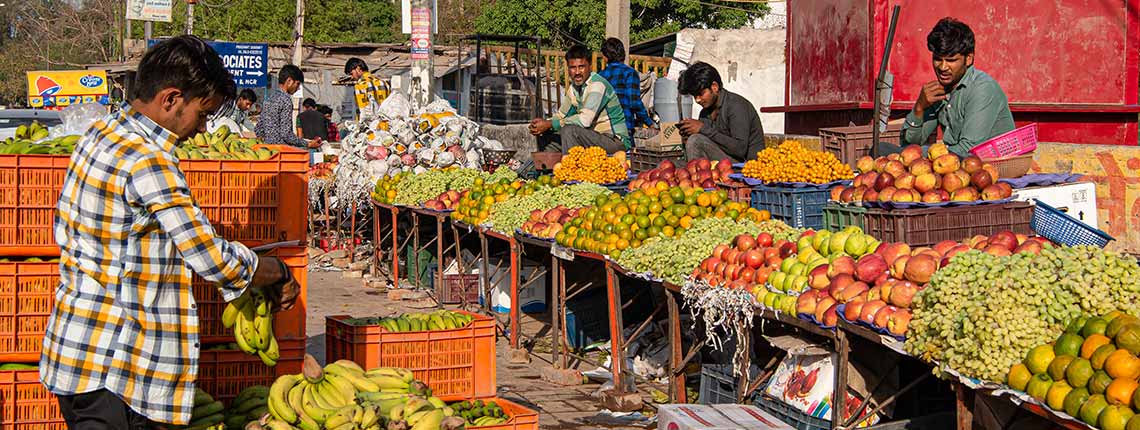
Heeding the United Nations call to share transformative approaches to local action on World Cities Day, Focal Cities Coordinator Jenna Harvey talked to Shalini Sinha and Avi Majithia of WIEGO’s Focal Cities Delhi team about their work to advance a more just and inclusive “people’s plan” in Delhi’s master plan.
Across the Global South, master plans are one of the oldest and most powerful tools in determining where certain activities will take place and what land area and supporting infrastructure are required. They articulate a vision of what the city should look like, providing the blueprint for other urban development and policymaking.
Over three years, WIEGO’s Focal Cities Delhi team was part of a diverse coalition of civil society groups, activists and informal worker organizations that came together in the Main Bhi Dilli (“I, Too, Am Delhi”) campaign presenting an inclusive vision for the city.
Jenna: Master plans across the Global South have been used as a tool for the exclusion of informal workers. What is the history of master planning in Delhi?
FCD: Every 20 years Delhi constructs a new master plan. These have always been written by non-elected “technical experts”, with little or no space for public participation. When citizen consultations took place, these were accessible only to elite groups and lobbyists. As a result, previous plans have reflected a vision of Delhi that clashes with reality. They imagine the city as neatly zoned and filled with office-going professionals who live in formal housing. In fact, only 24 per cent of Delhi’s population lives in planned settlements. Of Delhi’s nearly 5 million workers, it is estimated that over 80 per cent are informally employed.
Not only have previous plans not supported the vast majority of Delhi residents, but they have been used to justify the displacement of poor communities from their homes and workplaces.
Jenna: How did the campaign push for this top-down process to change, and for Delhi's master planning process to include a wide range of perspectives?
FCD: Far in advance of the drafting process, WIEGO brought together informal worker representatives, housing and other activists, and planners and academics to discuss what was needed from the master plan. The campaign evolved out of these discussions.
A guiding principle of the campaign was that those most affected by the existing failures of policy and planning have the best insights into alternatives. To elicit these solutions required doing what the state has not done – “demystifying” the technical aspects of the plan and creating forums for these stakeholders to make recommendations for change.
Activists and planners working on informal worker and housing rights, but also gender and environmental issues, organized over 100 public meetings. These took place in informal settlements and workplaces across Delhi and sourced new insights on the problems, priorities and demands of its communities. These meetings supported communities to see the master plan as a tool for change and to explore how to connect their priorities with provisions in the plan.
Jenna: What key demands emerged from this process?
FCD: Many of the campaign’s demands turned the power of the plan on its head. For example, although historically used as a tool to harass and marginalize informal workers, the campaign showed that the master plan could be formulated to foster integration by making visible their sites of work – by putting informal livelihoods “on the map”. Our key demands were:
- Recognition of informal workers’ right to use public space for livelihood purposes.
- Formal allocation of space for informal work, such as vending zones for street vendors and sorting sites for waste pickers.
- Flexible zoning and promotion of mixed-use zoning at the scales of homes and neighbourhoods, to accommodate home-based work, for example.
- A model of multipurpose community centres to decentralize access to social services to underserved and often geographically isolated communities.
Jenna: The campaign partners secured an unprecedented level of public participation. Where do things stand now and what lessons does this hold for other movements?
FCD: There have been significant victories: For the first time, the draft master plan recognizes the informal economy as the largest employer in the city and allows for mixed-use zoning, which is favourable for informal workers. It also makes mention of improving social infrastructure such as anganwadi (child-care) centres in densely built urban informal settlements. However, the plan generally falls short in laying out the policy infrastructure necessary to implement the inclusive vision it alludes to. That said, the language itself provides a foothold for claims-making, and the work of the Main Bhi Dilli has produced a policy roadmap for activist groups to use in their advocacy as the master plan is approved and implemented. Most importantly, the campaign opened up citizen participation in the planning process like never before, establishing a precedent for movements in Delhi to use technical planning processes as spaces for organizing and co-production of policy agendas.
We learned that the master plan has the potential to be a tool of inclusion and recognition for informal livelihoods in city planning. Master planning should be seen as a mechanism for community engagement, and community knowledge should be seen as a critical asset in this process. Engaging the public in a “co-productive” way enables creative solutions around use of public space and service and infrastructure priorities.
For activists and social movements, the campaign shows that it can be more strategic to subvert the power of master plans rather than to organize against them. We recommend starting early, given the work required to understand the mechanisms of the plan and entry points for popular education and claims-making. The strength of the Main Bhi Dilli was also its heterogeneity – the mix of causes and expertise represented through the campaign were critical in its success. Finally, a solutions-oriented approach is essential. It is easy to diagnose the problems with master plans, but harder to get inside the problems to propose pathways for change. We found that in taking this extra step, the government entity tasked with developing the plan was much more responsive to our movement, especially when we positioned our work as an asset to theirs.
Top photo: A weekly market in South Delhi. Credit: Rashmi Choudhary
Related Posts
-
Informal Economy Theme
-
Informal Economy Topic
-
Occupational group
-
Region
-
Language
